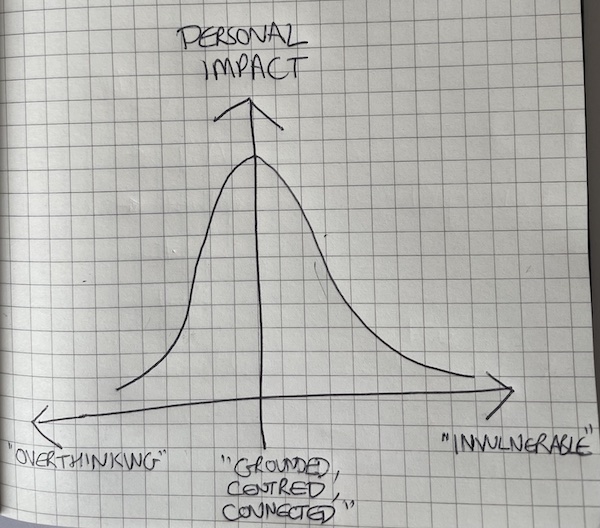I spend so much time “in my head” - conceptualising, analysing, strategising and intellectualising. Perhaps you can relate. After all, many leaders have relied upon their intellect - their schooling, decision-making and problem-solving skills - to rise to the senior level where they now find themselves.
For me, my mind has definitely been a strength and source of success - underpinning my Oxford education, strategy consulting track record, and the like - but, like most of our success formulae, it’s also created limitations and held me back in some ways. And “being in my head” is one.
It can be easy to be too “in your head”. This can show up in various ways, such as:
For myself, I’ve noticed that ‘being in my head’ can send me into ‘invulnerable mode’ (strong, analytical, confident - but not necessarily able to speak to people’s hearts) or into ‘overthinking mode’ (hesitant, less confident).
But my most powerful self comes from neither of these places; it comes from a place of groundedness, embodiment, and connectedness. It’s when I feel on fire, on mission; it’s a real sense of having heart, head and body aligned.
This, for me, is what ‘leading from the heart of the storm’ looks like.
Think of it something like this:

Four key benefits of getting centred
In the spirit of leading from a position of openness and connectedness instead of intellect and invulnerability, let me share some of my own story and use that to illustrate some lessons that you can take away and apply. I’ve been on a journey to become more centred and grounded within myself, and more connected with others and the present moment. Looking back, I’ve made great progress - but looking ahead, I know there’s more to do.
So - here are four ways that becoming more more centred and grounded improve our leadership. As I said, these aren’t theoretical; they’ve all come from my personal experience this year.
1. High performance (Stick Drop Principle)
I recently played a game where a stick was held (horizontally!) in front of me and dropped without warning. The challenge was to hold your hand above the stick and then, once it started falling, to reach down and grab the falling stick before it hit the ground.
It turns out that your brain can’t respond quickly enough: once your conscious mind understands the stick has dropped and sends messages to your hand to grab it, it’s too late.
I couldn’t do it, and I wasn’t surprised as I felt I’ve never been great at hand-eye coordination (so I told myself). But the trainer taught us to centre ourselves on our breathing, bring our full focus onto the stick, and then respond instinctively.
I amazed myself by becoming the best in our group. I was able to create a ‘flow state’ within seconds, as time seemed to slow down and I was completely present to the movement of the stick.
This was a profound experience for me, that I’ve labelled the "Stick Drop Challenge Principle”: Centring oneself creates a focus and flow that makes high performance effortless.
2. Decision making under pressure
I was recently part of a team in a competitive and stressful situation, with curveballs being thrown at us left, right and centre. For the first few minutes, we were a mess as we debated the right course of action amongst ourselves, only to be constantly behind the chain of events.
And then we slowed our thinking down, took some deep breaths, and got centred. We entered a place of calm focus. And from there, we were able to make simple, bold decisions that took us forward.
I spoke with a business owner just yesterday who was struggling to make a major decision around his company’s future. We shifted the discussion out of his analytical comfort zone to that place of embodiment and commitment, and the way forward became clear almost immediately.
3. Influence (Connection Principle)
“Wow, Richard, this conversation has been amazing. I felt so connected.”
This comment came from somebody I met at a conference last month. As they spoke, I put aside my usual mental chatter (finding something witty to say next, or analysing what they were saying, and the like), made sure I was mentally connected to my own body (aware of my breathing, for example) and then focused intently on them.
And after five minutes of conversation like that, as we wrapped up, I received that comment. NOT something I typically get at a business conference.
Hence the "Connection Principle". People truly feel it when you're connected to yourself and deeply focused on them.
Now imagine the impact if you could create such a sense of connection with your most important stakeholders…
4. Communication (Jester Principle)
To move others, you have to be moved yourself.
This is a saying I have that I normally apply to business communication settings, and I recently discovered the truth of it in quite a different context.
I was in a team development workshop where I was assigned the role of ‘jester’, and had a few minutes to try to make the other team smile or laugh. I started to try to connect with them, making eye contact - but they had prepared and ignored me really effectively, walking away or closing their eyes. How could I make them laugh if I couldn’t even connect with them? I failed to achieve my goal.
But as I reflected I discovered what I should have done: make myself laugh! That’s actually how I deploy humour in daily life - say or do things that make me laugh, and I find others laugh too.
So… communicating doesn’t always have to be about connecting with others; it can be connecting so deeply with yourself that others will ‘connect themselves’ to you.
Hence the “Jester Principle". Make yourself laugh and you'll make them laugh. Be moved yourself, and you'll move others.
What this means in practice
What all this really means is that it’s incredibly powerful to build our own personal practice of becoming still and centred. In the pressure of our day, the temptation is to accelerate our thinking and accelerate our activity; but slowing down the frenetic mental energy opens up a new level of performance, decision-making and influence.
When others first told me this I didn’t quite believe it. I’m a fast and analytical thinker; surely, quicker is better? Well, yes, but not from a place of distraction, noise and an unawareness of what’s really going on internally. When you’re grounded, focused and in flow … that’s where the magic happens.
If you’re a high-level leader who’s ready to transform your own leadership and lead even more powerfully from the eye of the storm, perhaps we should have a conversation.



